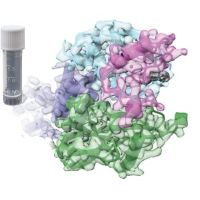Specification
| Description | Recombinant protein from the full-length sequence of homo sapiens homocysteine inducible ER protein with ubiquitin like domain 1 (HERPUD1), transcript variant 2 (NM_001010989). |
| Organism | Homo sapiens (Human) |
| Expression Host | Human Cells |
| Tag Info | His or DYKDDDDK. Please contact us if you need further information or require specific designed tag. |
| Purity | Greater than 90% by SDS-PAGE gel |
| Uniprot ID | Q15011 |
| Entry Name | HERP1_HUMAN |
| Gene Names | HERPUD1 HERP KIAA0025 MIF1 |
| Alternative Gene Names | HERP KIAA0025 MIF1 |
| Alternative Protein Names | Homocysteine-responsive endoplasmic reticulum-resident ubiquitin-like domain member 1 protein (Methyl methanesulfonate (MMF)-inducible fragment protein 1) |
| Application | Antigens, Western, ELISA and other in vitro binding or in vivo functional assays, and protein-protein interaction studies; For research & development use only! |
| Buffer | Purified protein formulated in a sterile solution of PBS buffer, pH7.2, without any preservatives |
| Endotoxin | Endotoxin level is < 0.1 ng/µg of protein (<1EU /µg) |
| Length | 391 |
| Molecular Weight(Da) | 43720 |
| Protein Sequence | (The sequence of expressed protein may have some variation from the sequence shown below. Please contact us for the exact sequence.) MESETEPEPVTLLVKSPNQRHRDLELSGDRGWSVGHLKAHLSRVYPERPRPEDQRLIYSGKLLLDHQCLRDLLPKQEKRHVLHLVCNVKSPSKMPEINAKVAESTEEPAGSNRGQYPEDSSSDGLRQREVLRNLSSPGWENISRPEAAQQAFQGLGPGFSGYTPYGWLQLSWFQQIYARQYYMQYLAATAASGAFVPPPSAQEIPVVSAPAPAPIHNQFPAENQPANQNAAPQVVVNPGANQNLRMNAQGGPIVEEDDEINRDWLDWTYSAATFSVFLSILYFYSSLSRFLMVMGATVVMYLHHVGWFPFRPRPVQNFPNDGPPPDVVNQDPNNNLQEGTDPETEDPNHLPPDRDVLDGEQTSPSFMSTAWLVFKTFFASLLPEGPPAIAN |
Background
| Function | FUNCTION: Component of the endoplasmic reticulum quality control (ERQC) system also called ER-associated degradation (ERAD) involved in ubiquitin-dependent degradation of misfolded endoplasmic reticulum proteins (PubMed:16289116, PubMed:28827405). Could enhance presenilin-mediated amyloid-beta protein 40 generation. Binds to ubiquilins and this interaction is required for efficient degradation of CD3D via the ERAD pathway (PubMed:18307982). {ECO:0000269|PubMed:16289116, ECO:0000269|PubMed:18307982, ECO:0000269|PubMed:28827405}. |
| Pathway | |
| Protein Families | |
| Tissue Specificity | Widely expressed; in the brain, expression seems to be restricted to neurons and vascular smooth muscle cells. Present in activated microglia in senile plaques in the brain of patients with Alzheimer disease. |
QC Data
| Note | Please contact us for QC Data |
| Product Image (Reference Only) |  |

